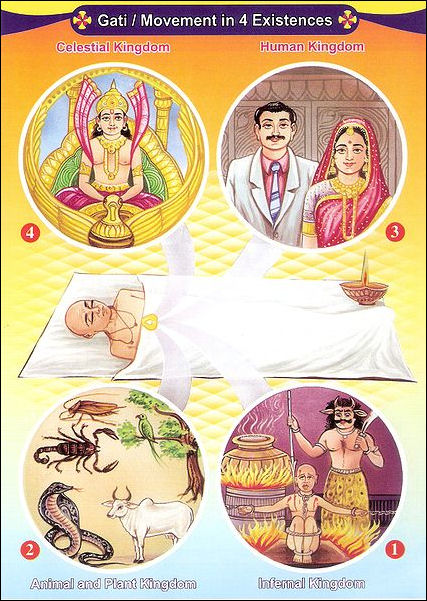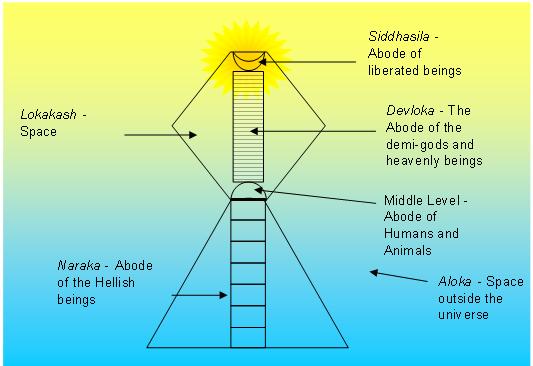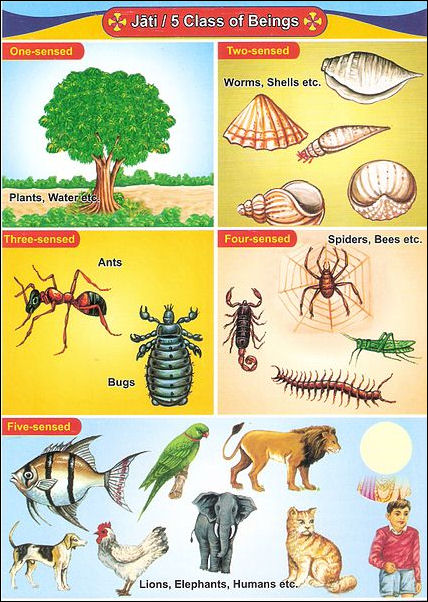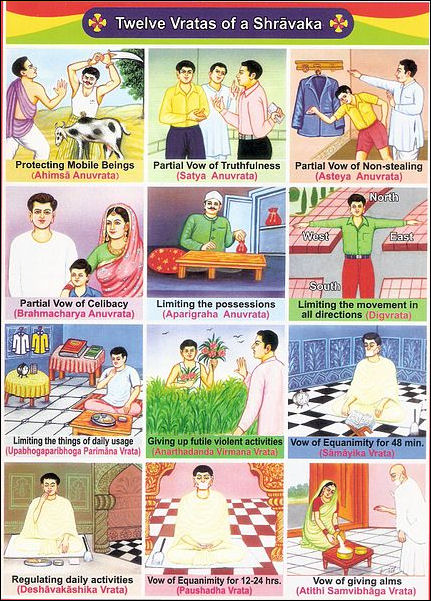JAIN BELIEFS

Gati or Existences Jains believe that every soul is potentially divine and every individual has the potential to achieve “moksha” (nirvana) — the setting fee of the individual from “sanskura”, the cycle of birth and death — by following the teachings of the “tirthankaras”. The emphasis is on asceticism and arresting passion. Karma is not viewed as determinate but rather something that has be overcome and liberated from.
The Jains say that nature is complex and every objects has three aspects: a substance, its inherent qualities, and the infinite number of forms in can take in time and space. Jains have no creation myth because they believe the universe has no beginning or end and goes through an infinite number of cosmic cycles, each with periods of ascent and descent that are reflected in the rise and fall of human civilization. The 24 tirthankaras appear to help man cross the "great ford" to cosmic paradise during each half cycle.
The ancient belief system of the Jains rests on a concrete understanding of the working of karma, its effects on the living soul (jiva ), and the conditions for extinguishing action and the soul's release. According to the Jain view, the soul is a living substance that combines with various kinds of nonliving matter and through action accumulates particles of matter that adhere to it and determine its fate. Most of the matter perceptible to human senses, including all animals and plants, is attached in various degrees to living souls and is in this sense alive. Any action has consequences that necessarily follow the embodied soul, but the worst accumulations of matter come from violence against other living beings. The ultimate Jain discipline, therefore, rests on complete inactivity and absolute nonviolence (ahimsa) against any living beings. [Source: Library of Congress]
To abide by the Lay Jain code you may think that there is a high degree of self-interest in the doctrine of ahimsa, because in Jainism harm done to other beings is considered harm to oneself since it attracts much karma and thus hinders the soul's journey to liberation. But this is merely an appearance — the level of detachment that a Jain seeks to cultivate eliminates self-interest. [Source: BBC]
Jains reject the authority of the Vedas and the spiritual supremacy of the Brahmin. They have no priests and don't worship individuals, even Mahavira; they only worships classes of human beings like “arhats” (holy ones) and “siddhas” (perfect ones). Gods are not given any kind of prominent role. They are regarded as living creatures no better or worse than other living creatures
Western religion has traditionally divided the world into the mortal and non-mortal. Hindus saw many more possibilities. "The Jains," wrote Boorstin, "declared there were not only two possibilities but seven, which gave them their doctrine of Maybe, wrapping both the darkness and the dazzling brilliance of creation in a twilight of doubt." The Jain hell has 8.4 million hells. The worst sinners end up in a bottomless forever.
Jain Doctrines

Swaminarayan
Dharmavanshi Acharya Jains believe in three basic principals: 1) “kantavada”, the belief there are no absolutes; 2) “karmas-vada”, efficiency of action; and 3) “ahimsa”, non violence. Part of the principal of non-absolutes is the "doctrine of maybe." which is further broken down into seven predictions: maybe yes, maybe no, maybe yes and no, maybe indescribable and three more combinations of these. The Jains said that a statement like "that is a book" is dogmatic and wrong because it is implies permanence. The Jains would say "maybe that is a book."
At the heart of individual worship for ascetics are the “Mahavratas” (“The Great Vows”): 1) “ahimsa” ( non violence); 2) “satya” (speaking the truth); 3) “brhmacharya” (abstaining from sex); 4) “asteya” (not taking nothing that is not given); 5) “aparigraha” (detachment from people). There is a parallel set of vows for lay people called “anuvratas” and they include vegetarianism and refraining from work that might hurt living things.
Some Jains are ordained as monks and nuns, and many of these live the lives of wandering ascetics. Most Jains are laity. They live in the material world. They support the wandering ascetics, by giving them food and shelter. The ascetics in turn give the laity religious guidance. The six acceptable occupation of Jains are government work, writing, the arts, farming, crafts and commerce. Farming is regarded as okay because the only harming of creatures that takes place is unintentional. Trade and commerce are regarded as the ideal profession because little harm is done to creatures.
The Tattvartha Sutra formally lays out the 14 stages which one must pass through to achieve moshka. Few advance beyond the 6th stage. The 14th stage is achieved when all karmas have been overcome and the soul is like a “rock” and can not be disturbed in any way. All Jain are expected to engage in “Samayika” , an ancient form of meditation that lasts for 48 minutes and involves renouncing all possessions, accepting and asking for forgiveness and reciting the prayer: “Friendship to all living forms, delight in the qualities of the virtuous ones, unlimited compassion for all suffering beings, equanimity toward all who wish me harm, may my soul have this dispositions now and forever.”
Ahimsa
Jain ethics generally center on the principle of ahimsa — noninjury to living creatures. Ahimsa originated in Jainism but is also widely accepted in Hinduism and Buddhism. According to the BBC: “Ahimsa is often translated simply as non-violence, but its implications are far wider; it is more than not doing violence, it is more than an attitude, it is a whole way of life. And for modern Jains the concept also includes the positive elements of working for justice, peace, liberation, and freedom, if doing so does not involve violence. |::|
Literally translated, Ahimsa means to be without harm; to be utterly harmless, as Jains see it, not only to oneself and others, but to all forms of life, from the largest mammals to the smallest bacteria. Mahatma Gandhi was a famous advocate of Ahimsa, as it informed his policy of passive resistance, satyagraha (combining the Sanskrit terms for 'truth' and 'holding firmly') - which he adopted towards the occupying British forces during the period leading up to Indian independence. Some Jains have criticised this as being a subtle form of violence. |::|
A) Ahimsa touches every area of life, so Jains: 1) are vegetarian; 2) don't use cloth whose production hurts animals or humans; and 3) take care to preserve life in everything they do. B) Jains are also not allowed to do jobs that cause harm, for example: 1) those involving furnaces or fires; 2) those in which trees are cut; 3) those involving fermentation; 4) trading in meat products, honey or eggs; 5) trading in silk, leather etc; 6) selling pesticides; 7) selling weapons; 8) digging; 9) circus work involving animals; and 10 zoo work.
Ahimsa basics: 1) Refraining from violence: One should refrain from violence to any living creature. Violence includes: physical violence, mental violence and verbal violence. 2) Violence can be committed in several ways, all of which should be avoided: committing it yourself, asking others to commit violence, encouraging others to commit violence, assenting to or condoning violence. 3) Violence involves violent intention as well as physical harm. This is controversial among Jains and both the points below are disputed. Accidental physical harm may not count as violence if there was no violent intention, but lack of compassion or care may be a sufficiently violent intention. 4) Ahimsa is positive as well as negative, so it's good to: forgive, promote tolerance, be compassionate, give to charity, work for peace, protect the environment, work for kindness to animals, and do one's daily work in a just and honest way.
Jain Beliefs About Ahimsa
According to the BBC: Jains believe that the only way to save one's own soul is to protect every other soul, and so the most central Jain teaching, and the heart of Jain ethics, is that of ahimsa (non-violence).” The Jain founder “Mahavira taught that: ‘there is no quality of soul more subtle than non-violence and no virtue of spirit greater than reverence for life.’ In practical terms the biggest part that ahimsa plays in the lives of lay Jains today is in the regulation of their diet. [Source: BBC |::|]

Punishment in Hells
Jains believe that life (which equals soul) is sacred regardless of faith, caste, race, or even species. Do not injure, abuse, oppress, enslave, insult, torment, torture or kill any creature or living being. In following this discipline Jain monks may be observed treading and sweeping in their temples with the utmost of care so as to avoid accidentally crushing crawling insects, or wearing muslin cloths over their mouths in case they should accidentally swallow a fly.
Jains say 'Ahimsa paramo dharmah' (Non-violence is the supreme religion). According to the BBC: Jains believe that violence in thought and speech is as bad as physical violence, so they try to control things like anger, greed, pride and jealousy. Jains also believe that getting others to do harm, or allowing others to do harm, is as bad as doing harm yourself. Most Jains believe that ahimsa doesn't just mean not doing harm — it also means working positively to promote tolerance, forgiveness and compassion, and to help those who are less fortunate. So ordinary Jains give regularly to charity. [Source: BBC |::|]
Jains and Living Things
The cornerstone of Jain philosophy is the belief that all living things, even the tiniest insects. have a immortal soul ( “jiva” ) that is continually reincarnated within the bounds of karma. Karma is seen as a form of matter that is attracted to the soul through good and bad desires. According to the BBC: Jains condemned any form of animal sacrifice as part of religious rituals. Animals must not be kept in captivity, starved, or treated cruelly. Jains believe that all living creatures depend on each other. One text says "All life is bound together by mutual support and interdependence." Mahavira said: "One who neglects or disregards the existence of earth, air, fire, water and vegetation disregards his own existence which is entwined with them".

Jain universe
The Jains classify living things into five categories determined by how many senses they process: 1) invisible things with low levels of consciousness and no senses; 2) vegetables and plants that only have touch; 3) some insects with only touch and smell; 4) butterflies and wasps with taste, smell and touch; and 5) all higher animals including man with the five senses.
Steven M. Kossak and Edith W. Watts from The Metropolitan Museum of Art wrote: “Mahavira taught that to avoid accumulating bad karma, one should not harm any living things. This is the doctrine ahimsa, the most important concept in Jain teaching. Because of their reverence for all life, Jain monks preached against brahminical animal sacrifices and introduced strict vegetarianism. Since a human soul can be reborn as an animal or insect, and since all forms of life have souls, even the smallest creature should not be harmed. To prevent this, devout Jains wear face masks when they are out- side to avoid inhaling insects, and gently sweep the path in front of them before taking a step. Jains avoid farming because their ploughs might injure burrowing animals. The Jain emphasis on nonviolence influenced both Buddhism and Hinduism and established a tradition which many prominent Indians such as Gandhi have followed.” [Source: Steven M. Kossak and Edith W. Watts, The Art of South, and Southeast Asia, The Metropolitan Museum of Art, New York]
Jains believe all life shares a common soul and life can be found everywhere even in the wind, in the earth and in rocks. . Unlike Buddhism and Hinduism, they view all life forms as being equal: there were no higher orders or lower orders. Jains condemn the killing of all animals, and insist on a pure vegetarian diet. The concept of vegetarianism in India and the concept of non-violence promoted by Gandhi was invented by the Jains.
Jains, Animals, Insects and Plants
Jains don't eat meat or root vegetables. Jains eschew eating onions, garlic and other tubers because of insects that might be killed in the digging process and because they involve taking the lives of the plants. Jain filter their water so they don’t swallow any microbes. They believe even a blade of grass may have a soul. Strict Jains are fruitarians and believe that flames contain beings and they should never start or put out a fire. Bathing is forbidden because it harms both creatures in the water and creatures on the body. Lamps are not lit at night because they may harm the moths and insects that fly into them.

Hierarchy_of_Beings
Jain monks wear gauze masks over their nose and mouth, so they won’t accidently kill an insect by inhaling it, and don’t walk around in the dark lest they accidently injure some creature they can not see. Some Jains carry a kind of feather duster, or bristle brush to swish away insects that may cross their path. Some Jains have sweepers that clear a path so they will not accidently kill an ant by steeping on it. Some Jains were special hollow shoes that have minimum impact on the ground so no insects are crushed.
Some Jains wear a piece of white paper folded over their mouth. It symbolizes commitment to nonviolence. It is regarded a symbolic because its wearers can still inhale insects through their nose.
Jainism priest take care of stray cats and dogs and run hospitals for sick and injured animals and birds. In shelters for stray cats and dogs there is a special room for insects. Jain insect shelters are provided with grain, sealed and opened only after a dozen or so years so the insects have had a chance to die naturally.
Passage on Jain Respect for Life
The Acharanga Sutra is the first of the twelve Angas, part of the agamas (religious texts) which were compiled based on the teachings of 24th Jina Mahavira, one of the main teachers of Jainism. 'Acaranga-sutra,' I reads: Earth is afflicted and wretched, it is hard to teach, it has no discrimination. Unenlightened men, who suffer from the effects of past deeds, cause great pain in a world full of pain already, for in earth souls are individually embodied. If, thinking to gain praise, honour, or respect ... or to achieve a good rebirth...or to win salvation, or to escape pain, a man sins against earth or causes or permits others to do so....he will not gain joy or wisdom....Injury to the earth is like striking, cutting, maiming, or killing a blind man...Knowing this man should not sin against earth or cause or permit others to do so. He who understands the nature of sin against earth is called a true sage who understands karma. [Source: Translation by A. L. Basham; from abridged version in Theodore de Bary, Sources of Indian Tradition (New York: Columbia University Press, 1958), pp. 62-3]
And there are many souls embodied in water. Truly water...is alive....He who injures the lives in water does not understand the nature of sin or renounce it....Knowing this, a man should not sin against water, or cause or permit others to do so. He who understands the nature of sin against water is called the true sage who understands karma....By wicked or careless acts one may destroy fire-beings, and moreover, harm other beings by means of fire....For there are creatures living in earth, grass, leaves, wood, cowdung, or dustheaps, and jumping creatures which...fall into a fire if they come near it. If touched by fire, they shrivel up...lose their senses, and die....He who understands the nature of sin in respect of fire is called a true sage who understands karma.

12 Vratas of Shravaka
And just as it is the nature of a man to be born and grow old, so is it the nature of a plant to be born and grow old....One is endowed with reason, and so is the other; one is sick, if injured, and so is the other; one grows larger and so does the other; one changes with time, and so does the other....He who understands the nature of sin against plants is called a true sage who understands karma.
All beings with two, three, four, or five senses....in fact all creation, know individually pleasure and displeasure, pain, terror, and sorrow. All are full of fears which come from all directions. And yet there exist people who would cause greater pain to them....Some kill animals for sacrifice, some for their skin, flesh, blood,...feathers, teeth, or tusks;...some kill them intentionally and some unintentionally; some kill because they have been previously injured by them,...and some because they expect to be injured. He who harms animals has not understood or renounced deeds of sin....He who understands the nature of sin against animals is called a true sage who understands karma. . . .
A man who is averse from harming even the wind knows the sorrow of all things living....He who knows what is bad for himself knows what is bad for others, and he who knows what is bad for others knows what is bad for himself. This reciprocity should always be borne in mind. Those whose minds are at peace and who are free from passions do not desire to live [at the expense of others]....He who understands the nature of sin against wind is called a true sage who understands karma. In short be who understands the nature of sin in respect of all the six types of living beings is called a true sage who understands karma.
Image Sources: Wikicommons Media
Text Sources: “World Religions” edited by Geoffrey Parrinder (Facts on File Publications, New York); “Encyclopedia of the World’s Religions” edited by R.C. Zaehner (Barnes & Noble Books, 1959); “Encyclopedia of the World Cultures: Volume 3 South Asia “ edited by David Levinson (G.K. Hall & Company, New York, 1994); “The Creators” by Daniel Boorstin; “A Guide to Angkor: an Introduction to the Temples” by Dawn Rooney (Asia Book) for Information on temples and architecture. National Geographic, the New York Times, Washington Post, Los Angeles Times, Smithsonian magazine, Times of London, The New Yorker, Time, Newsweek, Reuters, AP, AFP, Lonely Planet Guides, Compton’s Encyclopedia and various books and other publications.
Last updated December 2023
